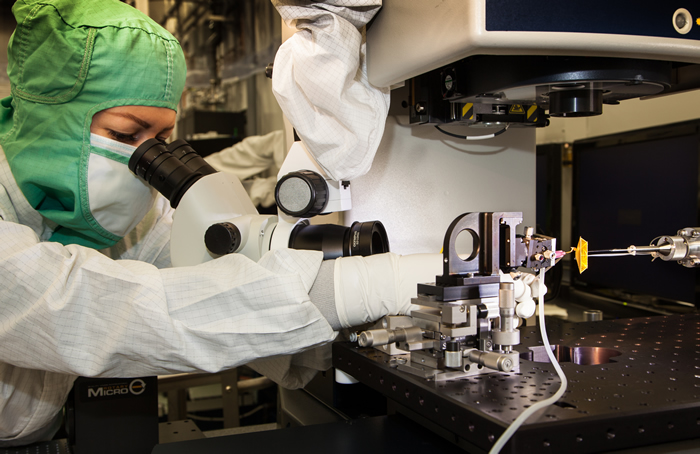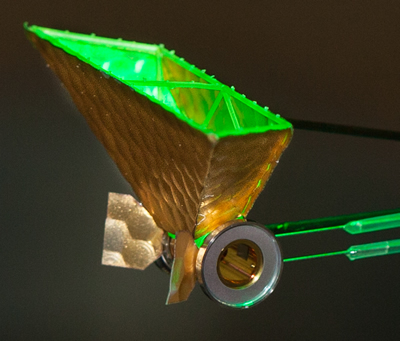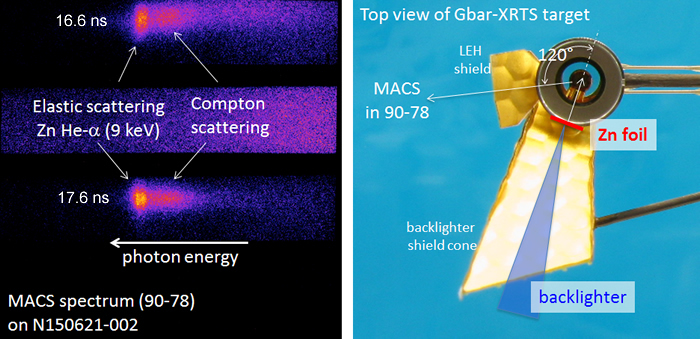Experimental Highlights - 2015
June
Measuring Ionization at Extreme Densities
Two NIF experiments to qualify a new platform for x-ray Thomson scattering (XRTS) measurements, part of a Discovery Science campaign to better understand the effects of extreme density on the ionization state of a plasma, have produced “very exciting” results.
Modeling ionization balance in a plasma—the number of bound compared to unbound electrons—is crucial to the understanding of high energy density matter, determining many important plasma properties. Plasma properties at ultra-high densities also are directly relevant to inertial confinement fusion (ICF), because these densities are reached in imploding target capsules as they approach stagnation.
 Target Fabrication technician Kristie Segraves attaches a light shield during the final steps in fabricating a GigaBar3 target in Bldg. 381. The target was used in the June 21 Thomson scattering experiments. Credit: James Pryatel
Target Fabrication technician Kristie Segraves attaches a light shield during the final steps in fabricating a GigaBar3 target in Bldg. 381. The target was used in the June 21 Thomson scattering experiments. Credit: James Pryatel “Thomson scattering is a unique tool to look at the microphysics of dense plasma,” said NIF & Photon Science physicist Tilo Döppner. “Measuring the onset of K-shell ionization (when electrons closest to an atom’s nucleus are knocked out of their orbits) is of great interest in the plasma community for benchmarking ionization models in dense matter,” he said. “It’s also interesting for NIF, because K-shell ionization of carbon changes the absorbing properties” in CH (plastic) capsules, which could affect measurements of how much capsule mass remains as the fusion capsule implodes.
 Close-up of the GigaBar3 target showing the large backlighter cone; the shield protecting the hohlraum’s laser entrance hole (LEH) from light from the backlighter is on the lower left.
Close-up of the GigaBar3 target showing the large backlighter cone; the shield protecting the hohlraum’s laser entrance hole (LEH) from light from the backlighter is on the lower left. The NIF experiments, which build on similar experiments conducted at the University of Rochester’s OMEGA Laser Facility, were conducted on June 21. They are designed to measure in-flight electron density, temperature, and ionization balance in CH and beryllium target capsules which are exposed to pressures approaching or exceeding one gigabar (one billion atmospheres)—conditions which currently only can be achieved in implosion experiments at NIF.
The first shot successfully qualified a new dual-cylinder graphite Bragg crystal for the Mono Angle Crystal Spectrometer (MACS) and tested a molybdenum-helium alpha x-ray source. The second shot measured XRTS spectra of an imploding CH capsule at 450- and 200-micron radius (see graphic) in an 0.8-scale gold hohlraum; 188 beams delivered 514 kilojoules of ultraviolet light to the hohlraum and backlighter in a 225-terawatt peak power pulse.
“We acquired great data,” Döppner said. “In the raw data you can see the separation of the elastic and inelastic scattering; this is very exciting. The brightness comparison tells you how many electrons are bound, and that tells you the ionization state of the plasma.” (In elastic scattering there is no loss of photon energy when the x-ray photons collide with electrons. Compton scattering is inelastic scattering, in which some of the energy of the photons is transferred to the electrons.)
 (Left) Time-resolved x-ray Thomson scattering spectra of the imploding CH capsule taken at 16.6 nanoseconds (upper spectrum; capsule radius about 450 microns) and 17.6 ns (lower spectrum; capsule radius of 200 µm). Zinc helium-alpha x rays are generated at the hohlraum wall and scattered off the capsule towards the MACS spectrometer in Diagnostic Instrument Manipulator 90-78. The broadening of the Compton scattering at 17.6 ns is consistent with 6x compression of the CH ablator. (Right) Illustration of the GigaBar3 target configuration. Credit: Tilo Döppner
(Left) Time-resolved x-ray Thomson scattering spectra of the imploding CH capsule taken at 16.6 nanoseconds (upper spectrum; capsule radius about 450 microns) and 17.6 ns (lower spectrum; capsule radius of 200 µm). Zinc helium-alpha x rays are generated at the hohlraum wall and scattered off the capsule towards the MACS spectrometer in Diagnostic Instrument Manipulator 90-78. The broadening of the Compton scattering at 17.6 ns is consistent with 6x compression of the CH ablator. (Right) Illustration of the GigaBar3 target configuration. Credit: Tilo Döppner Döppner said additional experiments later this year will measure the scattering spectrum closer to stagnation, when the capsule density is even higher. Discovery Science experiments in Fiscal Year 2016 will measure the ionization balance in beryllium at unprecedented electron densities of 1025/cm3 and high electron degeneracy, providing insights into the compressibility of beryllium capsules used in NIF ignition experiments.
Also contributing to the experiments were Paul Neumayer of the GSI Helmholtz Center in Darmstadt, Germany, and Roger Falcone of UC Berkeley, the external principal co-investigators; Dominik Kraus of UC Berkeley, the primary postdoc on the project; LLNL postdoc Benjamin Bachmann and LLNL researchers Andrea Kritcher, Laurent Divol, Nino Landen, and Rip Collins; John Kline and Austin Yi of Los Alamos National Laboratory; Luke Fletcher and Siegfried Glenzer of the SLAC National Accelerator Laboratory; Ronald Redmer of the University of Rostock; and Dirk Gericke of the University of Warwick. A representative of the UK’s Atomic Weapons Establishment also participated.




